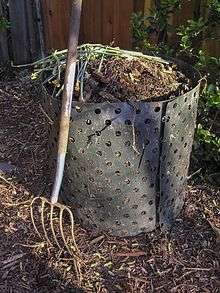Pitchfork


A pitchfork is an agricultural tool with a long handle and tines used to lift and pitch or throw loose material, such as hay, straw or leaves.
Description
A pitchfork is an agricultural tool with a long handle and long, thick, widely separated pointed tynes used to lift and pitch or throw loose material, such as hay, straw or leaves. True pitchforks typically have only two or three tines, while manure forks have four or more tines. However, some forks with more than three tines are also used for handling loose material such as hay or silage.[1] Other types of fork even up to ten tines with different lengths and spacing depending on purpose. They are usually made of steel with a long wooden handle, but may also be made from wood, wrought iron, bamboo, alloy, etc. In some parts of England a pitchfork is known as a prong[2] and, in parts of Ireland, a sprong refers to a 4-pronged pitchfork.[3] The pitchfork is similar to the shorter and sturdier garden fork.
Pitchforks and scythes have frequently been used as weapons by those who couldn't afford or didn't have access to more expensive weapons such as swords, or, later, guns.[4] As a result, pitchforks and scythes are stereotypically carried by angry mobs or gangs of enraged peasants.
In Europe, the pitchfork was first used in the early Middle Ages, at about the same time as the harrow. The pitchfork was originally made entirely of wood; today, the tines are usually made of hard metal.[1]
Symbolism, literary and artistic references
%2C_Farmer_with_a_Pitchfork._Oil_on_board.jpg)
Artistic usage
A notable American artistic display of a three-pronged pitchfork is in American Gothic, the painting by Grant Wood. In this painting it symbolizes hand labor. There are other paintings by various artists which depict a wide variety of pitchforks and other tools in use and at rest.[5]
Political usage

Because of its association with peasantry, the pitchfork is often a populist symbol and part of the nickname of populist leaders, thus:
- "Pitchfork Ben" (Benjamin Tillman)
- "Pitchfork Pat" (Pat Buchanan)
The Gangster Disciples, a street gang in the midwestern United States, use a three-pointed pitchfork as one of their symbols.
Religious symbolism
The pitchfork is often used in satire of Christian demonology in popular media, especially in early humorous cartoons where a popular joke was a caricature of an angel and a pitchfork-wielding devil sitting on the shoulders of the protagonist.
The Hellenistic deity Pluto wields a bident, a two-pronged weapon strikingly similar in form to a pitchfork.
See also
References
- 1 2 "Why All Pitchforks Are Not Alike". Retrieved February 4, 2016.
- ↑ Copper, Bob, A Song for Every Season: a hundred years of a Sussex farming family. London: Heinemann, 1971; p. 112
- ↑ Joyce, P. W. English as We Speak it in Ireland, p. 832. Talbot Press - via Google Books, 1920.
- ↑ "Medieval Men". Medieval-Period.com. Retrieved 2014-02-13.
- ↑ Ritch, Alan (2006-02-06). "Resting in the hay (1592-1900)". Hay In Art. Retrieved 2014-02-13.
External links
![]() Media related to Pitchfork at Wikimedia Commons
Media related to Pitchfork at Wikimedia Commons